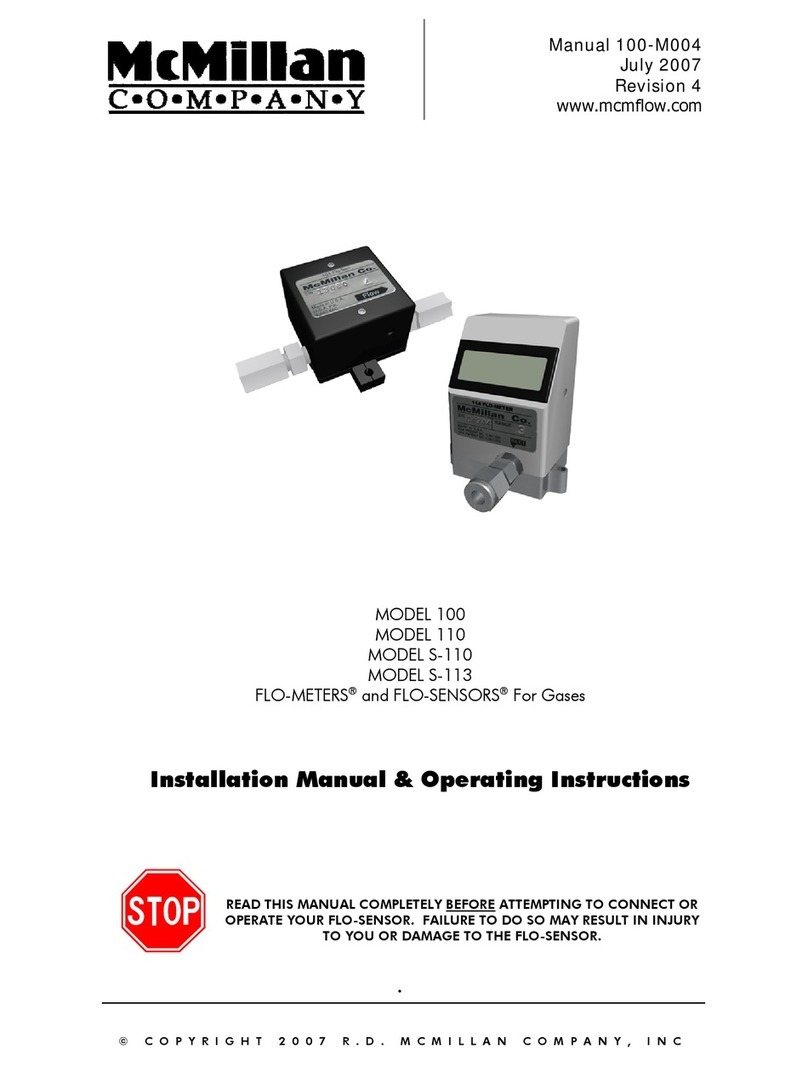
101-M002, pg. 2 of 42
TABLE OF CONTENTS
A. Introduction.................................................................................................. 3
1. Unpacking................................................................................................ 3
2. Product Overview And Principle Of Operation............................................... 3
3. Non-Standard Products (Z Suffixes) .............................................................. 4
B. Installation.................................................................................................... 5
1. General Considerations ............................................................................. 5
2. Mounting The FLO-SENSOR®or FLO-METER®.......................................... 6
3. Mounting a FLO-METER®Using an Optional Base Plate (Model S-111 only) ..... 7
4. Tubing Connections................................................................................... 8
5. Electrical Connections................................................................................ 9
a) Overview ..................................................................................... 9
b) Connecting A Cable Assembly............................................................... 10
c) Electrical Connections – Voltage Output Units (Standard Accuracy)............. 11
d) Electrical Connections – Voltage Output Units With Improved Accuracy
(H Suffix Only) ................................................................................... 12
e) Electrical Connections – Units With Both Voltage & Pulse Outputs .............. 13
f) Electrical Connections – Current Output Units (Model 107) ........................ 14
g) Electrical Connections – Current Output Units (Model 107) With
Improved Accuracy .............................................................................. 15
h) Using a 0-5VDC Output Power Adapter Package ..................................... 16
i) Using a 4-20mA Output Power Adapter Package (Model 107).................... 17
j) Using a 4-20mA Output Signal Converter Package (D-24VDC)................... 17
C. Operation .................................................................................................. 18
1. Start-Up ................................................................................................. 18
2. Entrapped Air or Gas ............................................................................... 18
3. Flow Readings......................................................................................... 18
a) 0-5VDC Analog Outputs ...................................................................... 18
b) Pulse Outputs ................................................................................... 20
c) 4-20mA Outputs.................................................................................. 20
d) Units with an Integral Display................................................................. 21
4. Operating at Flow Rates Outside the Calibrated Flow Range ......................... 21
a) Flows Above the Maximum Rated Flow.................................................... 21
b) Flows Below the Maximum Rated Flow .................................................... 22
5. Zero Adjustments..................................................................................... 22
6. Recalibration........................................................................................... 22
7. Calibrating FLO-SENSORS®or FLO-METERS®for different Liquids ................. 24
D. Maintenance And Product Care..................................................................... 25
1. General ................................................................................................. 25
2. Cleaning and Flushing ............................................................................. 25
3. Returning Units For Repair Or Recalibration ................................................ 25
E. Part Number Information.............................................................................. 27
F. Accessories................................................................................................. 28
G. Specifications.............................................................................................. 29
H. Dimensions ................................................................................................ 31
I. Connector Pin And Wire Color Cross Reference............................................... 36
J. Limited Warranty ......................................................................................... 37
K. Trouble Shooting Guide ............................................................................... 40
L. Contacting McMillan ................................................................................... 42




























